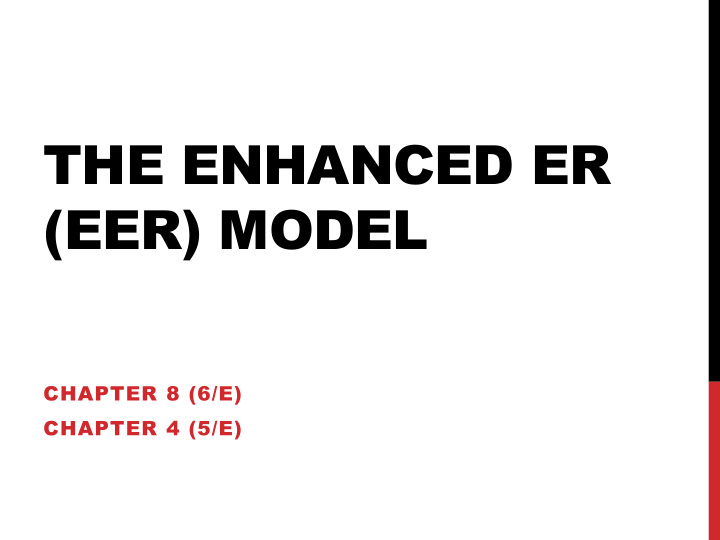



THE ENHANCED ER (EER) MODEL CHAPTER 8 (6/E) CHAPTER 4 (5/E)
CHAPTER 8 OUTLINE Extending the ER model • Created to design more accurate database schemas • Reflect the data properties and constraints more precisely • Address more complex requirements • Subclasses, Superclasses, and Inheritance • Specialization and Generalization • Modeling of UNION Types Using Categories 2
SPECIALIZATION AND INHERITANCE Specialization • Process of defining a set of subclasses of an entity type • Defined on the basis of some distinguishing characteristic of the entities in the superclass Describing the relationship • Superclass/subclass or Class/subclass • Supertype/subtype or Type/subtype Subclass can define: • Specific attributes • Specific relationship types Subclass can be a subclass wrt more than one superclass Type inheritance • Subclass entity has all attributes and participates in all relationships of superclass • Multiple inheritance if more than one superclass 3
GENERALIZATION Generalization • Process of defining a more general entity type from given entity types Reverse process of specialization Generalize into a single superclass • Original entity types are specialized subclasses • Entities in generalization must all come from subclasses 4
SPECIALIZED ENTITIES Every technician/secretary/engineer is EMPLOYEE an employee. SECRETARY Not every employee of superclass e 8 must be in a subclass (unless specified e 7 e 2 as generalization ). e 1 All properties of employee (attributes and relationships) are inherited by MANAGER e 5 e 3 specialized subclasses. TECHNICIAN e 6 Specialized entities might have e 4 e 10 additional attributes and be involved in e 9 additional relationships. ENGINEER Subclasses may be disjoint or overlapping . 5
CONSTRAINTS ON SUBCLASSES Disjointness constraint • Specifies that the subclasses of the specialization must be disjoint Completeness constraint • Specifies that every superclass entity must be in a subclass • Required of generalization Disjointness and completeness constraints are independent constraints 6
EER DIAGRAM WITH SUBCLASSES 7
REFINING CONCEPTUAL SCHEMAS Using specialization • Starting with entity type, define subclasses by successive specialization • Top-down conceptual refinement Using generalization • Starting with entity type, define superclasses by successive generalization • Bottom-up conceptual synthesis 9
MODELING WITH UNION TYPES • Union type or category • Represents a single superclass/subclass relationship with more than one superclass • Subclass represents a collection of objects that is a subset of the UNION of distinct entity types • Attribute inheritance works more selectively • Category can be total or partial Some modeling methodologies do not have union types • Usually (always?) clearer to use specification/generalization 10
UNION TYPES 11
REWRITING UNION AS SPECIALIZATION BANK BANK PERSON COMPANY PERSON COMPANY ⋃ ⋃ ⋃ oBANK oPERSON oCOMPANY ⋃ d ⋂ ⋃ OWNER OWNER OWNS OWNS REGISTERED VEHICLE REGISTERED VEHICLE ⋂ ⋃ ⋃ CAR TRUCK d ⋃ ⋃ CAR TRUCK rCAR rTRUCK 12
13
DESIGN CHOICES Many specializations/generalizations can be defined to make the conceptual model accurate • Constrain as disjoint/overlapping or total/partial as needed • Driven by rules in miniworld being modeled If all the subclasses of a specialization/generalization have few specific attributes and no specific relationships • Can be merged into the superclass C • Include in C one or more “type” attributes that specify the (virtual) subclasses to which each entity belongs Union types should generally be avoided 14
SUMMARY Enhanced ER or EER model • Extensions to ER model that improve its representational capabilities • Subclass and its superclass • Category or union type • EER diagrams 17
Recommend
More recommend